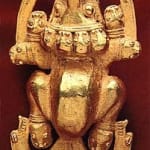Gold Pendant of a Jaguar Covered in Small Jaguar Heads, 500 CE - 1550 CE
Gold
3.25
PF.4109
In 1587, the Spanish explorer Diego de Sojos wrote: 'The quality of gold that abounds here (Costa Rica) is very great, and of good karat. The rivers are rich in...
In 1587, the Spanish explorer Diego de Sojos wrote: "The quality of gold that abounds here (Costa Rica) is very great, and of good karat. The rivers are rich in gold and the Indians extract it with calabashes in very large grains." Unfortunately, the intrinsic worth of gold was more valuable to the Europeans than artistry, and countless works of art were melted down. This accounts for the rarity of pre-Columbian gold jewelry, and makes the existing pieces even more precious. This extraordinary pendant is not only one jaguar but many. Small jaguar heads represent the larger animal's paws, and also line its neck as a form of headdress or necklace. From its mouth two sickle shaped bands emerge like snakes, ending in the jaws of two small heads. This configuration is perfectly balanced by the tail in the form of two semi-circles curving around the feet. When we see the remarkable detail, such as the multiple relief bands around the tiny heads, and the series of notches at the end of the two tails, it becomes clear that this pendant is more than a piece of jewelry. What we have here is a complex world of ideas and beliefs based upon a mythology which has long been shrouded in mystery. This gorgeous pendant combines superb artistry with myth in such a remarkable way it exudes its own energy and power; separate from yet equally brilliant as the brilliance of the gold itself.
Literature
V21



